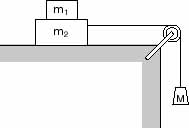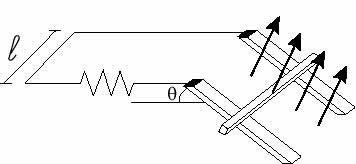Section I:
Mechanics
 |
| Block 1 of mass m1 is placed on block 2 of mass m2, which is then placed on a table. A string connecting block 2 to a hanging mass M passes over a pulley attached to one end of the table, as shown above. The mass and friction of the pulley are negligible. The coefficients of friction between blocks 1 and 2 are between block 2 and the tabletop are nonzero and are given in the following table. |
 |
|
(a) |
Suppose that the value of M is small enough that the blocks remain at rest when released. For each of the following forces, determine the magnitude of the force and draw a vector on the block provided to indicate the direction of the force if it is nonzero. |
| i. | The normal force N1exerted on block 1 by block 2 |
| ii. | The friction force f1exerted on block 1 by block 2 |
| iii. | The force T exerted on block 2 by the string |
| iv. | The friction force N2 exerted on block 2 by the tabletop |
| v. | The friction force f2 exerted on block 2 by the tabletop |
(b) | Determine the largest value of M for which the blocks can remain at rest. |
(c) | Now suppose that M is large enough that the hanging block descends when the blocks are released. Assume that blocks 1 and 2 are moving as a unit (no slippage). Determine the magnitude of a of their acceleration. |
(d) | Now suppose that M is large enough that as the hanging block descends, block 1 slipping on block 2. Determine each of the following. |
| i. | The magnitude a1of the acceleration of block 1 |
| ii. | The friction force a2of the acceleration of block 2 |
Section II:
Electricity and Magnetism
 |
A conducting bar of mass m is placed on two long conducting rails a distance l apart. The rails are inclined at an angle q with respect to the horizontal, as shown above, and the bar is able to slide on the rails with negligible friction. The bar and rails are in a uniform and constant magnetic field of magnitude B oriented perpendicular to the incline. A resistor of resistance R connects the upper ends of the rails and completes the circuit as shown. The bar is released from rest at the top of the incline. Express your answers to parts (a) through (d) in terms of m, l, q, B, R, and g. |
(a) | Determine the current in the circuit when the bar has reached a constant final speed. |
(b) | Determine the final constant speed of the bar. |
(c) | Determine the rate at which energy is being dissipated in the circuit when the bar has reached its constant final speed. |
(d) | Express the speed of the bar as a function of time t from the time it is released at t = 0. |
(e) | Suppose that the experiment is preformed again, this time with a second identical resistor connecting the rails at the bottom of the incline. Will this affect the final speed attained by the bar, and if so, how? Justify your answer. |